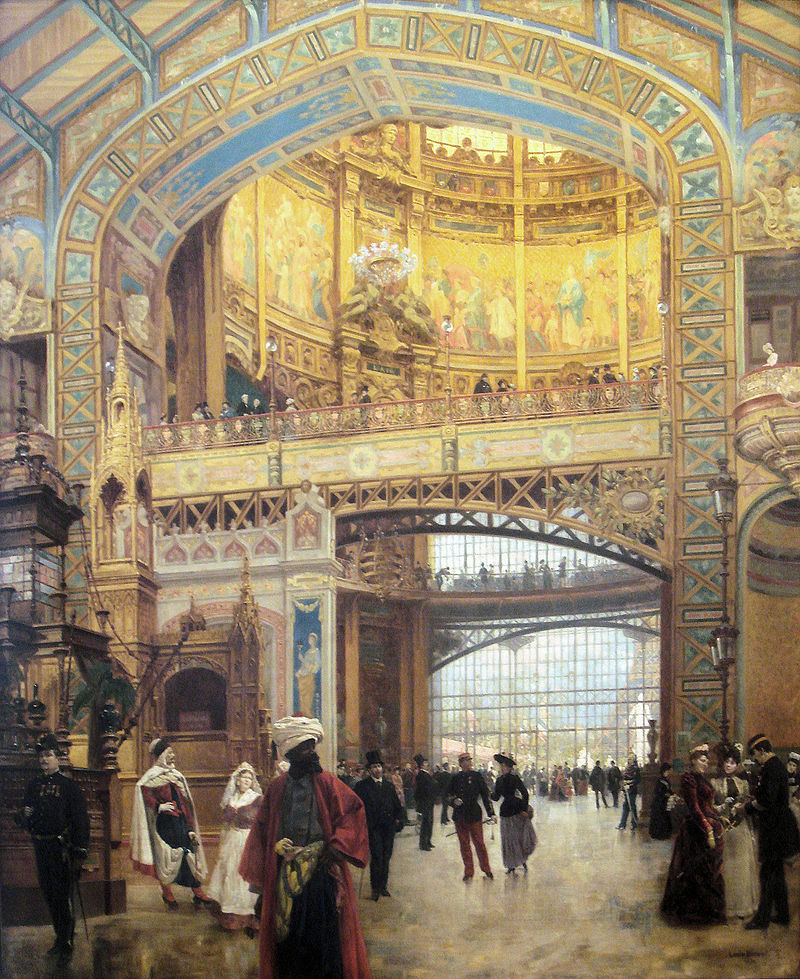Mrs Dalloway, Psychology, and Interwar Changes

Central Dome of the Gallerie des Machines, Exposition Universelle de Paris, 1889, Louis Béroud
In class, we have been doing much work on early 20th century literature, both fictional and non-fictional. We began the semester by discuss the American psychologist, William James, whose ideas on psychology presented a vision of psychology that embodied the attitudes of the romantic Belle-Époque. He viewed the human psychology as a flowing stream that at once has a coherent vision of itself and yet is always experiencing situations under new lights. He took interest in the connections of thoughts, the “ands” or “buts”. Yet, on the other hand, Sigmund Freud, another one of the greats, believed that people could replay experiences in their minds, and Silvan Tompkins took this view further by discussing analogues – situations which remind humans of past existences. These contrasting views on psychology lead me to the topic for today’s entry: interwar changes.
Pictured left are to pieces of artwork from before and after the war. While I will not specifically discuss paintings today, I would like to ask readers to use these artworks as visual representations of the changes brought in the Interwar Era while reading today’s entry; use these paintings to picture understand the changes in mindset heralded by the War.
The most important thing that we should note when discussing the interwar changes is the war itself – by that, I mean the First World War, of course. This war was unprecedented in almost every aspect. More destructive technologies made their debut and brought death on a scale that was unheard of. Also terrifying were the putrid conditions of trench warfare and the attrition wars which meant soldiers would lay for months in said putrid conditions. It was a life that was at the same time banal and terrifying. Because of this, soldiers returned traumatized, suffering from post-traumatic stress disorder (or shell shock as it was previously known). Sure, perhaps before the war, some aspects could be seen such as modern technology in the Russo-Japanese war or the German Wars of Unification, but it was still not on the same scale as in the Great War. These older wars were still more polite, for lack of a better word, in that many of them still relied on older forms of warfare like taking turns during a charge and fire session.

Fencing, 1920, Leon Chwistek
Much of the symptoms of shell shock – such as repeating disturbing thoughts, analogues and compulsions, or self harm – seems to discredit William James’ notions of the flowing and non repetitive of the human psychology. However, these romantic notions were not alone. Much of the horrors of the war whisked away romantic viewpoints and ushered in an era of arts and sciences that explore the darker aspects of humanity. Take Virginia Woolf’s novel, Mrs Dalloway. One of the main characters is a WWI veteran who suffers from extremely crippling PTSD and ends up killing himself. Other characters also have dislikable traits such as Peter Walsh’s self entitlement or Dr Holmes’s ignorance. Such a novel presents society as it is, exploring the character of humanity, rather than romanticizing it. Contrastingly, previous works such as Twenty-Thousand Leagues Under the Sea which instead explores the nobility and stoicism of human beings exemplified in the heroic Captain Nemo. Twenty-Thousand Leagues may present a Jamesian viewpoint of change and coherence as the Nautilus visits new waters while still retaining its identity as the Nautilus.
On a slightly different note, James did not live to see the end of the war and its psychological effects on society. This has left me wondering how he may have analyzed soldiers experiences of PTSD.
Other more obvious ways in which the war changed European society are of course in music. Take a string quartet by Johannes Brahms, the great 19th century Viennese romantic. The quartet focuses heavily on established musical forms, especially ones structuring harmonic development. The result: lush harmonies and flowing melodies. Brahms’s quartet can be seen as representing 19th century ideas on idealism and beauty. Now, contrast this with a quartet by Arnold Schoenberg, the great 20th Viennese modernist. This quartet focuses on breaking down previously established musical forms in favour of newer ones which abandon the tonal system. The result: dissonant harmonies and abstract melodies. This quartet, in turn, can be seen as representing modern ideas on the darkness of humans, similar to Freud’s theories on the idea that humans are driven by desires for sex and death. Much like these theories, the quartet is not for all audiences. Many audiences rejected such music as being hard to understand (ultimately bringing in what many lament was the fall of classical music) yet in the composer’s view, they represent WWI’s bitter pill: human beings are destructive animals.
The aesthetic and intellectual changes of the First World War ushered in profound changes to Western society. While many of us may say the concept of modernity with positive connotations, let us not forget that it brought about by some of the most negative experiences.
Until next time,
Aleksei Zhukov
